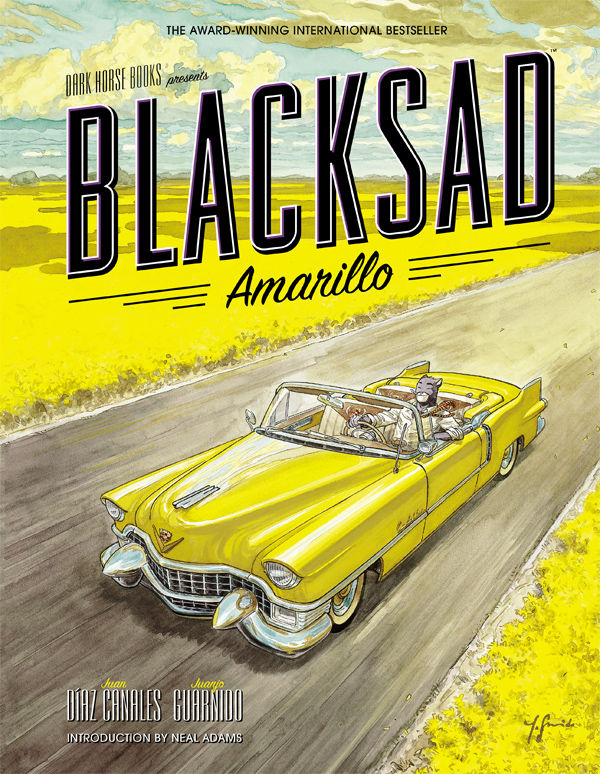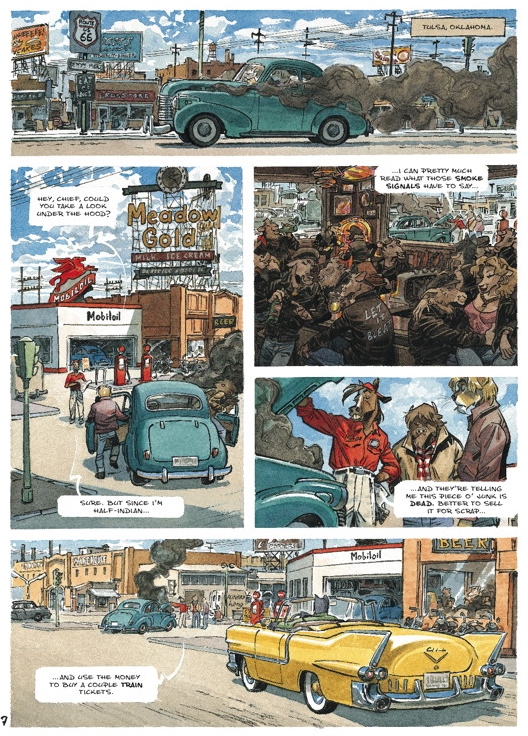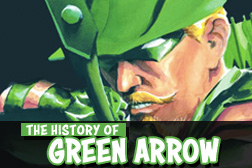It’s less black, and certainly nowhere near as sad, but Blacksad: Amarillo is a joyous return to one of the best examples of graphic storytelling in the world.
Writer: Juan Díaz Canales
Artist: Juanjo Guarnido
Publisher: Dark Horse (US)/Editions Dargaud (Europe)
Rating: 9/10
From the eye-catching opening panel of the fifth Blacksad story, partially recalling the iconic shots of Billy Wilder’s 1950 film Sunset Boulevard, it’s clear that the award-winning series has always had a cinematic eye. This is unsurprising given both writer Juan Díaz Canales and Juanjo Guarnido have a background in animation, the latter most famously being a lead animator on the Disney film Tarzan. Just like the movies, Blacksad: Amarillo transitions out of the noir of the 1940s, giving way to the Beat Generation and the open road.
Picking up almost immediately from where ‘Tome 4’ A Silent Hell (L’Enfer, le Silence) left off, private investigatorJohn Blacksad and his companion Weekly part company in New Orleans, where Blacksad is given the generous offer of a job from a gregarious Texan. Entrusted with driving his yellow Cadillac across country to Amarillo in Texas, Blacksad’s good fortune turns to bad luck (of course) when he plays the good Samaritan to a pair of beat poets who have tried to make off with a bike from a local gang. What follows is a tangled web of murder, a stolen manuscript, mistaken identity, and star-crossed lovers. In other words, Blacksad is back and we couldn’t be happier.
There’s something noticeably different about this Blacksad chapter. In the first English translation of the highly anticipated 2013 story, there’s an almost imperceptible shift in the tone of the book, something that’s difficult to put a finger on initially. The familiar characters are all there, but the world has moved on around them. Blacksad was always right at home in the atmospheric and moody shadows of 1940s noir, himself a perpetually downtrodden reminder of the inherent sadness of the social trends he’s traversed. Previous volumes have dealt with inter-racial violence and segregation (Arctic Nation) and communism (Red Soul), and here he finds himself on the bleeding edge of the counter-culture movement, the very antithesis of conformity. What’s different about this volume isn’t so much that Blacksad is out of place, but that he’s loving every minute of this pseudo-vacation from himself. Blacksad is having fun.
For some this may take some getting used to, and on a first read it does clash somewhat with our previous Blacksad experiences. Yet this is not a negative in the slightest, as the albums have always been full of dry wit and sly references to cultural icons. Here, a gun-toting flamingo is surely a stand-in for William S. Burroughs, complete with William Tell routine in a bar, and the Abraham Greenberg and Chad Lowell characters fill out the triptych as stand-ins for Allen Ginsberg and Jack Kerouac respectively. There’s certainly some of the emotional anguish found in On the Road, and at least four deaths to contend with, but there’s also the joyous vision of Blacksad riding down the highway on the back of a motorbike, serenely smiling to himself.
After mastering light and shadow in the very first volume back in 2000 (Somewhere Within the Shadows), Juanjo Guarnido has continually pushed the envelope in finding new ways to bring the lives of these anthropomorphic characters to audiences. Indeed, getting almost this far into a review and not having made a fuss that each of the characters is an animal is not just a testament to the storytelling power of Canales, but to Guarnido’s stunning artistry as well. Here it’s as if someone has suddenly turned the lights on, the desert landscapes and warmer temperatures literally bringing new light to the black cat, and bringing the mood up with it.
It’s often been said of these books that the clean, realistic lines make you forget that we are dealing with animals in human clothes, for they are all representing archetypes anyway. The lines have gotten sharper, and evolving watercolour techniques have ensured that the palette has become more vivid as well. Here’s it’s a deliberate choice, the yellow Cadillac shining like a beacon through this landscape. The circus setting during one chapter provides additional opportunities for splashes of colour, including a chance for Guarnido to expand his range of animals, not least of which is an angry koala clown. (Ironically, these are the most thematically dark sequences in the book). This is some of the best art in the business, and every panel can be framed and put on a wall.
The journey of Blacksad is almost the story of America, told from the point of view of the people in the margins. While Blacksad: Amarillo may not be as politically ambitious in its commentary as previous albums, or at least not as overtly as the literal black and white themes in Arctic Nation, it doesn’t have to be. Just as America was finding its own voice between the Second World War and Vietnam, Canales and Guarnido allow their lead some light before the darkness, and the narrative is necessarily more lightweight as a result. This is foreshadowed in the final gripping pages of the book, when both we and Blacksad come to the realisation that he can only take a break from the cycle of violence for so long. We can’t wait to see what this feline private dick makes of the future.
Agree or disagree? Got a comment? Start a conversation below, or take it with you on Behind the Panel’s Facebook and Twitter!
If you are an iTunes user, subscribe to our weekly podcast free here and please leave us feedback. That’s how we get more attention! Go do it now. We’ll be waiting right here.













